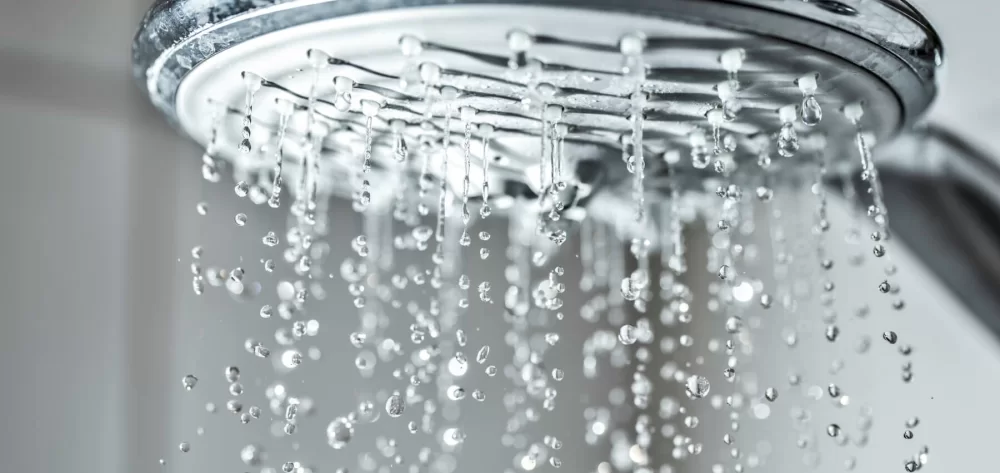Swiss use an average of 160 liter of water per person every day – and that is only accounting for homes and small businesses. Most of that water is not used for drinking (the recommended intake is just 2 to 3 liters per day), but for other things. So if you want to save water, there is absolutely no need to lower your water intake, as that is unhealthy and will not put a dent in your water consumption. Instead, you should look at your water use in the following areas:
Bathing: 150 liters of water-saving potential
If you enjoy taking baths, you will not enjoy being told (and likely already know) that bathing normally requires more water than showering. Bathtubs normally hold around 150 liters of water, though the exact amount varies between tubs. That is around the same amount of water you would use for 10 minutes of showering (or longer, if you follow the showering tips in the point below). If you have a small bathtub or only partially fill the tub, you will use less water.
Every time you opt for a three-minute shower instead of a bath, you save around 100 liters of drinking water. You can save the whole 150 liters of water by bathing in a (clean) natural body of water, like a lake, river, or the sea – unless you shower afterwards.
But there are many more ways to save water.
Showering: 30 liters of water-saving potential
Showering uses around 15 liters of water per minute, so how much water you use is determined by the length of your shower – or to be more precise, the length of time you leave the water running. Three minutes of showering under flowing water requires around 45 liters of drinking water.
You can save water by turning off the flow of water while soaping or shampooing yourself. Cutting water flow time from 3 minutes to 2 minutes will save 15 liters of water per shower. If you have a hard time keeping your showers short, you could consider showering with cold water. This little trick discourages long moments spent relaxing under the shower, and also cuts down water heating costs.
You can also get special shower heads designed to save water. These shower heads regulate pressure so that less water flows. Good water-saving shower heads can reduce consumption by around 50 percent. Some are designed so well that you hardly notice any difference from regular shower heads in terms of your showering experience. So using the right shower head can cut your water use without you having to cut down on shower time.
If you normally spend three minutes a day in the shower using a regular shower head, with the water flowing the whole time, you could save up to 30 liters per day by cutting down to two minutes and installing a water-saving shower head. In that case, you would only need around 15 liters of water.
Washing machine: 30 liters of water-saving potential
How much water you need to wash laundry depends on which washing machine you have, and which program you use. Many modern washing machines incorporate technology which helps minimize water and power consumption. On many washing machines, the most economical cycle includes the term “eco” in its title. Unless you are washing exceptionally dirty clothes, the prewash function is usually unnecessary.
Some washing machines detect how much laundry is being washed using sensors, and adjust the amount of water used to match the actual need. If your washing machine does not include this function, you should make sure to wait until you have enough laundry to fill the drum before washing a load. When buying a washing machine, it makes sense to choose a drum size which matches the size of your household (three to six kilograms for an individual, six kilograms or more for a family. The goal is to wash as few separate loads as possible.
The general rule: The newer the washing machine’s model, the less water it uses. If you use an old washing machine, getting a newer model can be a way to reduce your water consumption for laundry. Many old machines use up to 80 liters of water per load. Newer models generally use around 50 liters. So upgrading could save around 30 liters of water per cycle, on average. If you want to take saving drinking water to the next level, you can even install a rain collecting system and use rainwater to wash your laundry to avoid using any drinking water at all.
Watering the garden: 20 liters of water-saving potential per square meter
Each garden is different, but whether you have potted plants on your balcony or a vegetable plot out back, nothing grows without water. The amount of water you need depends on the types of soil and the kinds of plants you have. Informing yourself about the exact amounts of water required by different plants ahead of time is beneficial – not only to save water, but also to avoid damaging plants by watering incorrectly. On average, one square meter of planted garden needs around twenty liters of water per week. You can save much of that water automatically by growing plants with low water requirements.
For gardens in particular, using rainwater instead of drinking water is relatively easy. For many types of gardens, using rainwater is also healthier than watering with tap water over the long term. The ideal is to install a water barrel or tank which your roof’s rain gutters drain into. If you are not able to do this, you can also simply place a bucket outside. The bucket will fill up on its own when it rains, and you can then use the water for your garden during periods of no rain. In the best case, you can keep your garden watered without using any drinking water.
Timing also plays an important role in how much water you need. If you water your garden in the heat of the day, the water will evaporate quickly and may not even reach the roots. The result is that you will have to water your garden often to keep your plants from drying out. Watering your garden in the morning or evening when you lose minimal water to evaporation is recommended.
Keeping the soil’s surface loose helps to slow evaporation. You can loosen the soil using a hoe, or cover it in mulch or cut grass.
Installing a drip watering system can further reduce water use by minimizing evaporation and guiding water directly to the plants that need it. These systems generally use water very efficiently, but typically cost a lot and require effort to install.
Brown grass does not mean dead grass
Some plants can survive relatively long without watering, even in hot spells. Lawns, for example, may go brown during dry seasons without dying. As soon as the weather becomes more humid, they will regrow on their own, and you will have saved work and water. But obviously, brown lawns are not as pretty as lush green ones.
Toilets: 6 liters of water-saving potential
A toilet uses around 6 liters of water per flush, but may use more or less depending on the size of the tank and the flush mechanism. Many toilets let you choose between a large flush and a small flush. Either there are separate buttons for each option, or you can raise the flush lever to turn off the flush by hand at any time you choose.
There are also many simple accessories which can help reduce the water used by toilet flushing. A waterstop cistern weight is one such device. This is simply a weight which you connect to the flushing mechanism so that the outlet valve automatically closes as soon as you stop pushing the flush lever or button. Alternatively, you can swap out the entire flush mechanism for a more efficient model, or connect the flush cistern to a rainwater collection system so that it does not use any drinking water.
You could also consider whether it is really necessary to flush the toilet after every use. For example, foregoing the flush after urinating saves six liters of water each time. Important: If you live with other people, make sure that all members of your household are okay with this practice. But assuming you use the bathroom around four times per day, you could save around 12 liters of water per day by only flushing every second time.
Dishwasher: 3 liters of water-saving potential
The water-saving tips for dishwashers are practically identical to those for washing machines. The age of your dishwasher also plays a major role. Older models normally use more water (often more than 12 liters per cycle) than newer models (around 9 liters). So by using a newer machine, you automatically save up to 3 liters per wash.
The eco cycles included on some dishwashers normally use less water than the rapid wash program and other cycles. Energy efficiency ratings provided by manufacturers are generally based on the machine’s most economic program.
The size of your dishwasher also affects water usage. Large dish washing appliances generally use water more efficiently than small ones. Although large machines use more water per wash, they can clean far more dishes per load than small machines do. So as long as you have enough dishes to completely fill your machine before running a cycle, bigger machines are more saving in terms of water used per dish washed.
If, on the other hand, you do not have enough dishes to completely fill the dishwasher, then using a smaller machine makes more sense. As with laundry in washing machines, the rule for dishwashers is: Only run the machine if you have enough dirty dishes to fill it up to its full capacity.
Wash dishes by hand
Running a dishwasher to wash two or three dishes does not make economic sense. But washing dishes by hand is normally only more saving than using a dishwasher when you only use a few dishes and cannot completely fill a dishwasher. If you have to refill the washbowl at least once, or worse yet, wash your dishes under running water, then handwashing your dishes will generally use more water.
Are there any good reasons to save drinking water?
Climate changes are not currently as big a threat to water supply in Switzerland as they are elsewhere. The Federal Office for the Environment (FOEN) is confident that Switzerland will continue to have sufficient water supplies in the foreseeable future. Shortages during dry spell are only likely in areas with little groundwater. So from the environmental and social perspectives, saving water is not as important in Switzerland as it is in some other countries. Minimizing water use generally only becomes an issue during exceptional periods of extreme heat or low rainfall.
But apart from the environment, there is also another reason to save water: Your wallet. A single-person household, for example, pays around 2.05 francs per cubic meter (1000 liters) of drinking water. If you use 160 liters per day, you can expect to spend around 120 francs on water per year. The cost increases drastically if you use hot water (when bathing, for example). By reducing your consumption, you can lower your water and power bills. For savings-minded people, the lower costs are reason enough to cut down on water use.
Virtual water
The water we use at home is just a fraction of our actual water consumption. The bulk of our water use is in the form of “virtual” water – the water which is needed to produce the products we buy. It is not just the obvious things like drinks which consume water. Every agricultural and industrial product – from bread to clothing – requires water to make. So virtual water is indirect water consumption. Meat generally requires more water to produce than other food items. Cars are one of the consumer goods which are the most water-intensive to manufacture. The average resident of Switzerland uses around 4000 liters of virtual water per day.
More on this topic:
How to save on all household expenses in Switzerland
How to save money on groceries in Switzerland


 Deal of the Day
Deal of the Day 



